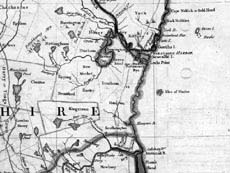By Mike Bisceglia
Hampton Union, Friday, June 2, 2006
[The following article is courtesy of the Hampton Union and Seacoast Online.]

[Courtesy photo]
In 1755, America did not extend much beyond the Alleghany (That was the correct spelling at that time.) River. This country wasn’t yet a nation, but it certainly was headed in that direction. The Northeast was filling quickly with British subjects.
The British weren’t alone in the Northeast. They had been welcomed to the region by Native Americans. The Abnaki, a close relative to the Penobscot, "The People of the East," saw the number of European faces grow from a few to several thousand. It might be said that in that year, the two groups were attempting the practice of peaceful coexistence. The new residents to the region, however, were about to have a jarring experience.
Much like the late fall and early winter of 2005, that same period more than 250 years ago was mild indeed. In the predawn hours of Tuesday, Nov. 18, the tranquility of the Hampton settlement came to an abrupt end.
A violent earthquake shook the region. Although there were no reports of death to any inhabitants of the region, there was extensive property damage. Furniture was tossed about; some 1,500 chimneys in the Boston area crumbled, and locally brick walls split apart.

[Courtesy image]
The men aboard a sailing vessel more than 200 miles east of Hampton thought they had hit a rock when the quake occurred. Many scientists believe that the quake could have registered 6.0 or greater in severity.
Some miles away in Greenland, Capt. Samuel Weeks was at rest. He had built a substantial brick house there in 1710. It is thought to be the oldest brick house in New Hampshire still standing today. It was the 18-inch beams that saved the house from the quake. So strong was the quake, however, that all the beams cracked. The intensity of the jolt, coupled with the reality of the French and Indian War, provided great fodder for Sunday sermons at several churches in the region.
The quake, although sizable, was not nearly as devastating as the giant quakes that hit Persia and Portugal that same year. Thousands died in each of those quakes. There is debate as to where exactly was the epicenter for the quake that rocked the southern New Hampshire region on that November morning. There are indications that the distinctive sand layer found in the Hampton marsh are consistent with a tsunami deposit from the same time period. If that is true, according to the Re-evaluation of Earthquake Potential and Source in the Vicinity of Newburyport, Mass., it could be the "first tsunami recognized along the U.S. Atlantic Seaboard and could point to a source of large earthquakes offshore from southeastern New Hampshire and southern Maine."
The earthquake of 1755 was not a fluke. The region does have a history of quakes at least dating back to the Plymouth Colony, in which a sizable quake was recorded in 1638. The quakes were frequent enough that Abnakis had a term for one. Nanamkipoda literally means "when the earth shakes."
Another damaging quake occurred on Oct. 29, 1727. The epicenter of this quake was probably located not far to the southeast from Hampton Beach. It caused damage from Boston to Portland, Maine.
With improved seismic testing in the latter years of the 20th century, a line of shakes in the 5.0 to 5.9 range occurred from Bangor Maine, to Philadelphia, Pa. Some nine quakes were recorded along that line. The liquefaction of soil which occurred in the 1727 (and possibly again in 1755) seems to have been centered in the Amesbury region. This site may be on an as yet unidentified fault.
Yes, Hampton, N.H., has seen more than a little bit of just about everything Mother Nature has to offer. Many of us can recall a jolt, a blizzard, or a hurricane of some note. All of these events and more help to shape the landscape of the region, and none of them take away from the beauty and livability that the area has to offer.
(Mike Bisceglia is a retired teacher and a resident of Hampton.)
